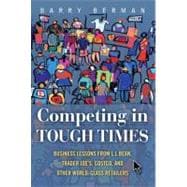
Note: Supplemental materials are not guaranteed with Rental or Used book purchases.
Purchase Benefits
What is included with this book?
Dr. Barry Berman is the Walter ‘Bud’ Miller Distinguished Professor of Business and Director of the Executive M.B.A. program at Hofstra University. He earned his Ph.D. degree in marketing management from the Graduate School and University Center of the City University of New York (CUNY).
Barry Berman is co-author of Retail Management: A Strategic Approach (Prentice Hall). This is the best-selling retail management college textbook in the world. Currently in its 11th edition, this book has been published in Canadian, Chinese, Indian, Philippine, and Russian editions. Dr. Berman has also published articles that have appeared in Business Horizons, California Management Review, The International Journal of Retailing and Distribution Management, and other journals.
Dr. Berman is Vice-President of the American Collegiate Retailing Association. He was also co-founder of the American Marketing Association’s Special Interest Group in Retail Management.
Barry Berman has consulted for Duane-Reade, Fortunoff’s, Kohl’s, Simon Properties, NCR, Lord & Taylor, Tesco-Ireland, and other retailers.
| Preface | p. xiv |
| Introduction | p. 1 |
| The Questionable Future Facing Global Retailers | p. 5 |
| Increased Competition Across Retail Formats | p. 8 |
| Retail Store Positioning and Competitive Strategy | p. 16 |
| Takeaway Points | p. 21 |
| Endnotes | p. 23 |
| Low-Cost Strategies I: Key Elements of a Low-Cost Provider Strategy | p. 27 |
| Implementing Low-Cost/Low-Price Strategies | p. 28 |
| Advantages of Being a Low-Cost Provider | p. 31 |
| Key Elements of a Low-Cost Retailer Strategy | p. 31 |
| Takeaway Points | p. 44 |
| Endnotes | p. 46 |
| Low-Cost Strategies II: Delivering Low Costs Through Minimizing Product Proliferation | p. 49 |
| Managerial Concerns Related to Product Proliferation | p. 52 |
| Causes of Product Proliferation | p. 64 |
| Reducing Product Proliferation: The Experience of Aldi, Costco, Stew Leonard's, and Trader Joe's | p. 68 |
| Takeaway Points | p. 75 |
| Endnotes | p. 76 |
| Differentiation Strategies I: Effective Human Resource Strategies | p. 81 |
| Strategic Benefits of Effective Human Resource Strategies | p. 82 |
| The Human Resource Strategies of Best-Practice Firms | p. 86 |
| Takeaway Points | p. 103 |
| Endnotes | p. 105 |
| Differentiation Strategies II: Enhancing the Service Experience | p. 111 |
| Consumer Satisfaction Studies and Analyst Reviews of the Benchmark Retailers | p. 113 |
| Employee Dimensions of the Service Experience | p. 117 |
| Nonemployee Dimensions of the Service Experience | p. 122 |
| Optimizing Customers' Web-Based Service Experience | p. 133 |
| Takeaway Points | p. 135 |
| Endnotes | p. 137 |
| Differentiation Strategies III: Developing and Maintaining a Strong Private Label Program | p. 141 |
| Advantages of a Strong Private Label Program to Retailers | p. 143 |
| Private Label Strategies of Successful Retailers | p. 148 |
| Takeaway Points | p. 166 |
| Endnotes | p. 167 |
| Implementing Cost-, Differentiation-, and Value-Based Retail Strategies | p. 173 |
| Cost-Based Strategies | p. 173 |
| Differentiation-Based Strategies | p. 179 |
| Value-Based Strategies | p. 188 |
| Auditing a Store's Cost, Differentiation, and Value Strategies | p. 195 |
| Takeaway Points | p. 198 |
| Endnotes | p. 200 |
| Appendix: Individual and Composite Financial Performance, Customer Service, and Worker Satisfaction Metrics of the Best-Practice Retailers | p. 203 |
| Introduction | p. 203 |
| Individual Performance Metrics of the Best-Practice Retailers | p. 205 |
| Composite Data on Best-Practice Retailers | p. 214 |
| Employee Satisfaction Measures of Best-Practice Retailers | p. 223 |
| Takeaway Points | p. 224 |
| Endnotes | p. 225 |
| Index | p. 229 |
| Table of Contents provided by Ingram. All Rights Reserved. |
The New copy of this book will include any supplemental materials advertised. Please check the title of the book to determine if it should include any access cards, study guides, lab manuals, CDs, etc.
The Used, Rental and eBook copies of this book are not guaranteed to include any supplemental materials. Typically, only the book itself is included. This is true even if the title states it includes any access cards, study guides, lab manuals, CDs, etc.